In my last piece I debunked the absurd premise behind assuming a proportional increase in road usage following road capacity expansion, as well as the premise that using road capacity is bad. I needed to fully explain the nonsense “logic” behind this stuff before critiquing any one video of the Urbanites. They all mindlessly repeat the same talking points anyway, so I didn’t want to have to keep re-explaining the faulty premises.
However, some of you may have thought I was strawmanning these people, so today we’ll be looking at a small fraction of the “proportionally induced demand” regurgitation out in the wild. We’ll start with Adam Something, a guy who unironically argued that children played on the streets – presumably in front of the draft horses – before cars were invented. I wanted to start with his explanation, because his video is particularly stupid even for this crowd.
How does adding more lanes cause more traffic?
Again to be clear, traffic and congestion are not the same thing. When we expanded our heli fleet we had lower average utilization, but higher traffic. You want both when you expand a road.
Take a city and a suburb. Between them is a two lane road, a bike path, and a train line. Most people commute by a bike or train.
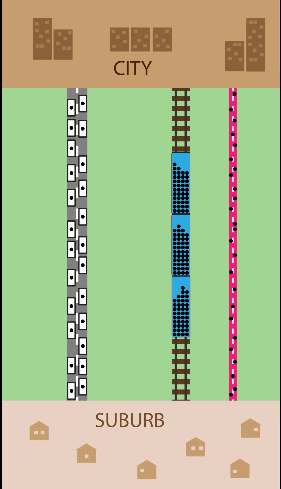
Here we have people who live in the amorphous blob known as SUBURB, and they can choose one of three tubes to transfer their meatbags to CITY. Boy I wonder what will happen when one of these meatbag tubes gets expanded. I bet we’ll magically get proportionally induced demand for no apparent reason.
The two lane road is jammed everyday, so the city widens it to four lanes. The road is no longer jammed.
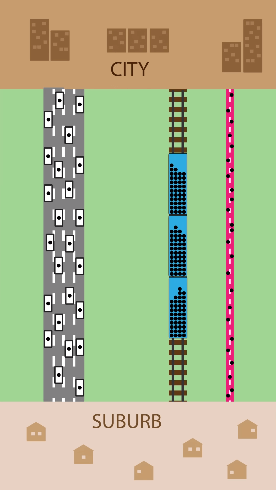
Sure seems like we solved the grey tube being jammed problem by widening the grey tube. You’d think that everything would be in order, but that’s because you’re not as smart as the guy who thinks children used to do interpretive dance on busy thoroughfares before cars were invented.
Now Karen and her fifty friends can all take their kids to school by car. Now a hundred rail commuters can drive, so they aren’t dependent on train schedules. Now twenty cyclists can drive because it’s faster.
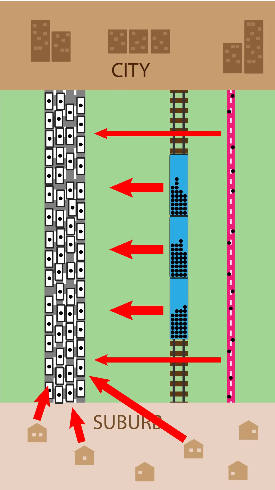
Oh my god noooooo! The grey flesh tube is being overloaded by the people who are inexplicably not choosing the blue or red flesh tubes. But, now the grey flesh tube is just as jammed as before. God, there doesn’t seem to be any way of fixing this.
The four lane road becomes jammed, so the city widens –
Why didn’t some of the people just go back to taking the train or biking now that their commute time is just as slow?

Adam Something has an very curious premise, that literally everyone who is biking or taking the subway will choose to drive until the exact, precise point where driving becomes as congested and slow as it was before. It won’t be that some of them quit when it’s half as bad as before, or one quarter as bad, or three quarters as bad. No, there is infinite demand for driving at the exact, precise level of congestion/speed we had before, and not one second slower or faster.
What about people who love biking? What about people who live extremely close to the bus train station, and work right next to the city’s train station? It’s still not going to be more convenient for them to drive. What about people who don’t have cars? What about people who don’t want to spend the gas money on their trip? What about people who were previously driving, hated standing in long lines for the train into town, but will now take the train since the lines are shorter? What about people who absolutely hate congestion, so they tried driving a few times, but when it filled back up with traffic they went back to biking? What if some people don’t own cars, and don’t want one just for this one trip?
But anyway, let me get back into character and pretend to be taking this seriously.
The four lane road becomes jammed, so the city widens it to six lanes. The road is no longer jammed.
Ruh roh guyz, I’m sensing something wrong with this solution.
Now twenty commuters can drive at a company fuel allowance instead of riding a bike, now a hundred rail commuters can drive, so they aren’t dependent on rail schedules. Now fifty high school students can drive instead of bike or train, because it’s faster.
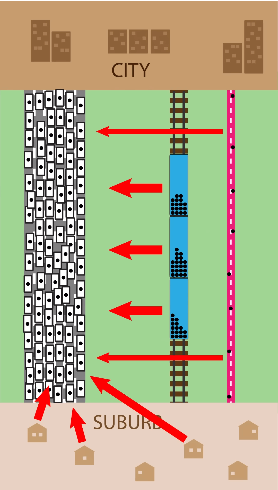
Looks like the grey tube is jammed up again because people hate the blue tube and the red tube. If you’re thinking at this point that you should just massively increase the grey tube, well let’s not get ahead of ourselves.
Due to lower ridership and revenue the train line cuts connections. Schedules become infrequent and impractical, so 200 rail commuters switch from train to car. The six lane road is jammed everyday.

Don’t you see you stupid Goy. You have to ride the train because if you don’t, rail service will cease to exist. Well you could just ride your bike down the red meat tube, but we’ll just sort of ignore that.
So the city widens it to 8 lanes. And so on until you have the Katy freeway.
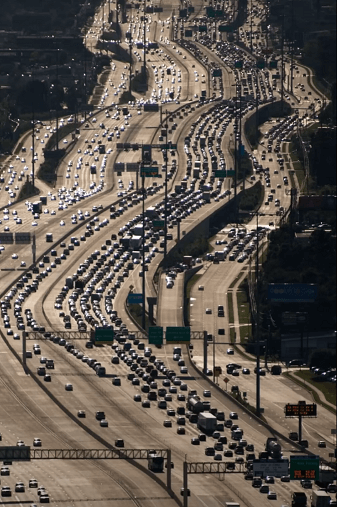
Katy Freeway
Oh noes. Not the Katy Freeway. Katy Freeway baaaaaad.
And this is how adding more lanes only causes more traffic.
Others make this same idiotic argument below, but Adam Something took it to the next level, because one of the premises he snuck in there was that public transit and cycling is so indefensibly terrible that people will only do it when they can’t drive. This isn’t true, but it’s hilarious that the urbanites will resort to making this argument because they’re so desperate to make driving a terrible experience for everyone that they’re willing to outright say that cars are better than public transit, and cycling in literally all situations except mass traffic jams. Remember, it’s not about walkability, it’s about fuck cars, and as we’ll see later, fuck suburbanites.
But his video is outrageously dumb for another reason. Let’s take a look at the final result of adding all these extra lanes, according to him.

Am I turning in my official SMART REDDITOR badge if I point out that you could just add two more lanes. Because you’ve got close to all the commuters already using cars, so just add more lanes and they’ll be set. Even in his own asinine constructed example you can literally solve the problem by just adding another lane at the end.

That was a disaster of a video, but he brought up the Katy Freeway. The Urbanite Bugcreatures have a hate boner for that highway, and I have to at least partially defend her honour, especially the expansions. Occasionally you’ll see pictures of Katy freeway stuck in traffic.
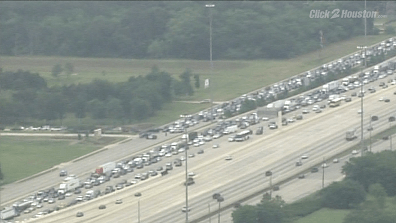
Some of these are just flat out misleading, such as this one above.
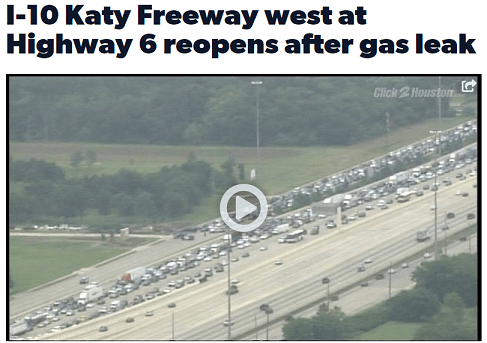
Sometimes they’ll pretend that the Katy Freeway is actually 23 lanes wide, as opposed to five lanes each way, or ten lanes wide, and four lanes wide at some points. In reality is has some frontage roads that run parallel to it for very short lengths. This allows snarky dipshits to Wow, Just Wow about how there are 18 lanes, or 23, or 26, depending on how dishonestly they count.
Don’t bother watching all hour of this man and his wife chronicle their journey down the Katy Freeway. At no point is the actual highway ever wider than five lanes plus two HOV lanes that disappear. At some points it’s down to three lanes each way. It used to always be three lanes each way and the traffic was horrible.
You can also watch this video showing highly sped up footage driving the major highways in Houston, Texas, including the Katy Freeway. It’s only six minutes long and I’d highly recommend watching it as you will see for yourself that these roads are not 13 lanes each way. You will also see him making excellent time on all these roads, and he even uses New Order’s remix of Blue Monday as the soundtrack. A very nice choice. Also, you can click on his channel and watch another of these videos he made.
Let’s look at media from people who actually live in Houston to see what actually happened when they added an extra lane each way, at least for some parts, to the Katy Freeway.
For decades, the Katy Freeway struck dread in the hearts of anyone having to drive it, particularly the suburbanites flocking to the subdivisions springing up on the prairie to the west of the city.
That dread resulted in a controversial, $2.8 billion plan to expand the freeway up to 18 lanes, including a tollway down the middle, from Washington Avenue to Highway 6 – a distance of 23 miles.
Four years after the project was completed, a comparative analysis of drive-time data for a three-year period before and after the expansion shows that at both peak and non-peak periods of the day, it takes less time to traverse the Katy Freeway than it used to.
The users of the Katy Freeway are spending a lot less time in their cars.
The morning commute from Barker-Cypress to Taylor, for instance, a distance of 19 miles, now takes, on average, 27 minutes. It used to take about 33 minutes. The evening commute on that stretch now takes an average of 28 minutes as opposed to 38 minutes and 30 seconds.
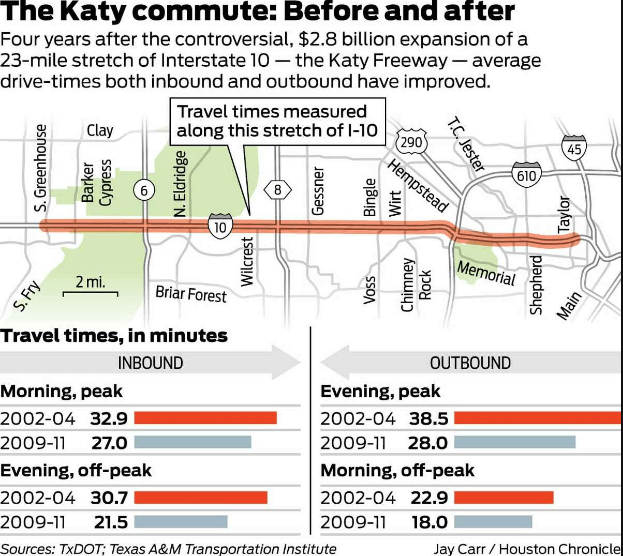
They even include this helpful little graphic so you can clearly see that yes, the transit times are lower. Moreover, Houstonians are spending less time in truly aggravating bumper to bumper congestion. Not having to deal with bumper to bumper congestion is very pleasant, although that benefit is harder to quantify.
“Before they did all that construction, inbound basically was congested all day long,” said Darrell Borchardt, a senior research engineer for the Texas Transportation Institute at Texas A&M University. “You would get stop-and-go speeds out there at 11 o’clock in the morning. Now, since that construction has been completed, with the additional capacity, they don’t have those issues in the middle of the day.”
Steve Morby is a veteran warrior of the Katy Freeway, having driven it before and after expansion to get to and from his job at Exxon Mobil Corp. until he retired last year. There are still some bottlenecks, Morby said, but generally it “moves very well.”
But it wasn’t the peak hour congestion that bothered him that much, he said. It was the congestion at off-peak hours that got to him.
“We used to go to concerts on Saturdays downtown and we would get frustrated at the bottlenecks at 6 p.m. on a Saturday,” Morby recalled. “That was the most frustrating thing. We accepted it at rush hour, but when it was congested at other times of the day … Now it’s rare that we experience anything but a very temporary delay.”
In addition to improved drive times and speeds, Borchardt said the expanded freeway has been a boon to the ability to deliver goods and services reliably on the west side of Houston.
“All your UPS trucks and FedEx trucks, with the expansion of I-10 they have a more reliable travel time,” he said. “They don’t really have to plan for additional travel time and delays.”
But it’s not all peachy for the Katy Freeway. One collection of traffic troons have their eyes on her and they are NOT HAPPY.
Fast-growing Texas cities have an enormous traffic problem — that much isn’t in dispute. But the response has been myopic: pouring more and more money into widening highways. Even the road engineers at the Texas Transportation Institute recently acknowledged there’s no way these cities can fund and build highway lanes fast enough to keep pace with population growth. That’s in no small part because widening and expanding highways fuels sprawl that induces more car trips, TTI acknowledged.
I’ll get back to the population growth part in a bit. First, here’s the front page of USA Streets Blog.
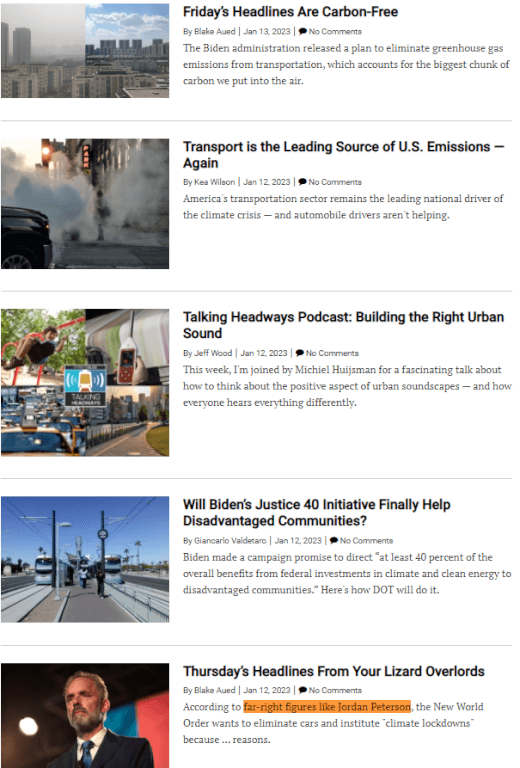
“Global Warming is going to kill us, muh disadvantaged communities, and Juden Peterstein is far-right.” Feel free to take what they have to say with a grain of salt, especially because all of their links in the 2015 article I’m referencing are broken.
In fact, reports [Houston Tomorrow propagandist Jay Crossley], all that money seems to be doing a great job of generating more traffic:
Houston commutes continue to get worse despite billions in spending on new road capacity. Traveling from Downtown outbound on the I-10 Katy Freeway to Pin Oak took 51% more time in 2014 than in 2011, according to Houston Tomorrow analysis of Houston Transtar data. The Houston region in recent years has been spending the most per capita on new roads of the ten largest metropolitan regions in the nation.
They’re even so helpful as to include this shot of the totally overcrowded Katy Freeway… that is also quite obviously not 23 lanes wide even in their own picture labeled “the 23-lane Katy Freeway.”
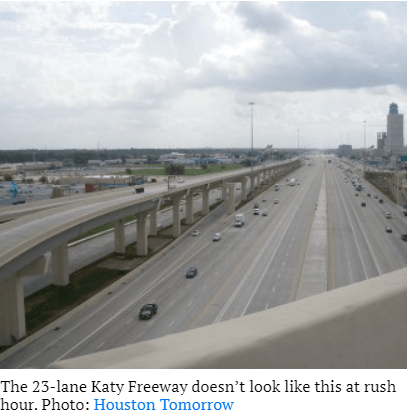
I would never bet a single dollar on analysis that I can’t see, let alone one done by some random propagandist and pushed by the antifas at USA Streets Blog. However, I can easily believe that the users of Katy Freeway are experiencing worse and worse commutes. Boy, I wonder what might have caused that?
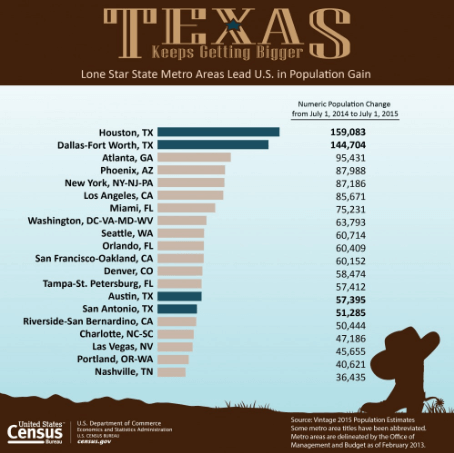
It might be some of that “population increase,” that they just handwaved away. You see, it’s almost like adding huge quantities of people to an area puts demand on the road infrastructure, just like all other public infrastructure.
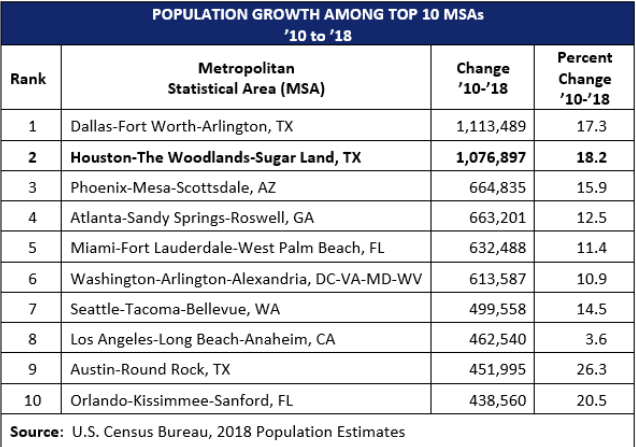
The above graphic is only over an 8 year period, and undersells the population growth.
New data from commercial real estate services company Cushman & Wakefield shows Houston gained 1,284,268 residents from 2010 through 2019. In terms of the number of new residents tallied during the past decade, Houston ranked second among U.S. metro areas, the data indicates.
From 2020 through 2029, Houston is projected to tack on another 1,242,781 residents, Cushman & Wakefield says. For the second decade in a row, that would be the second highest number of new residents for any metro area, the company says. That’s around the number of people who live in the Louisville, Kentucky, metro area.
For Houston, the 2020-29 forecast would represent a population growth rate of 17.2 percent, down from 21.6 percent for 2010 through 2019, Cushman & Wakefield says.
What’s the growth been like for Houston cumulatively since the 1980s?
Could it maybe be that 20% population growth per decade, and 125+% over four decades brings with it further burdens on the road system? Of course it does. Imagine this in a different context, where they shoved a huge number of migrants into a city and the population tripled. Then skyscrapers were built, and the sidewalk capacity was doubled. But the problem is that the sidewalks were still not large enough to contain all the new people, so they spill out into the street.
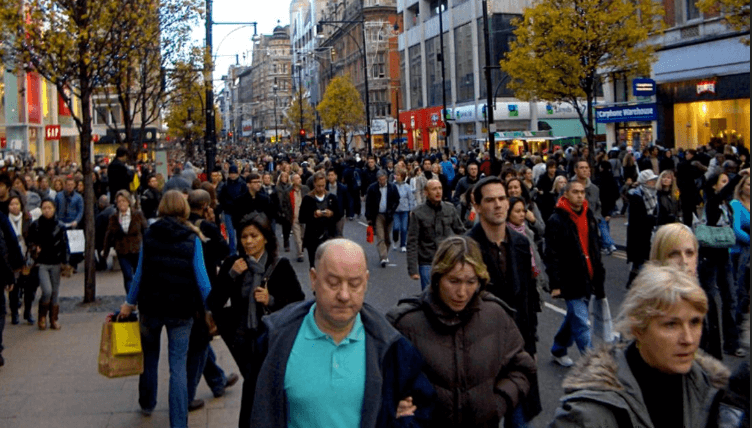 Imagine someone who came along and said “this just proves that expanding sidewalk infrastructure causes it to be more congested.”
Imagine someone who came along and said “this just proves that expanding sidewalk infrastructure causes it to be more congested.”
Anyway we find, unsurprisingly, the comments under that piece from people who actually live there are none too supportive of the narrative that the traffic antifas are pushing. I’ll transcribe this below.
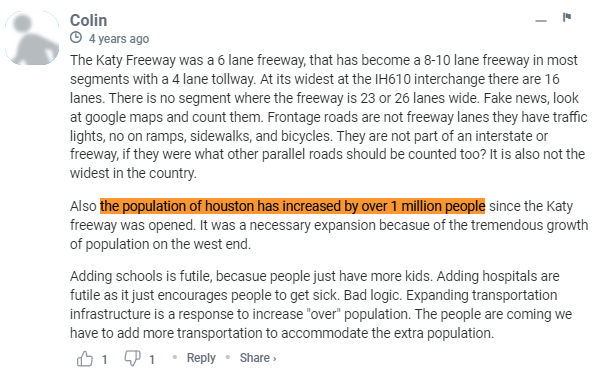
The Katy Freeway was a 6 lane freeway, that has become a 8-10 lane freeway in most segments with a 4 lane tollway. At its widest at the IH610 interchange there are 16 lanes. There is no segment where the freeway is 23 or 26 lanes wide. Fake news, look at google maps and count them. Frontage roads are not freeway lanes they have traffic lights, no on ramps, sidewalks, and bicycles. They are not part of an interstate or freeway, if they were what other parallel roads should be counted too? It is also not the widest in the country.

These people whine so much about the Katy Freeway because they think that one shot with some frontage roads means that the highway is actually twenty six lanes across, even though it isn’t even in that shot. There are other, bigger highways even in Canada, such as Highway 401 in Toronto.
Also the population of houston has increased by over 1 million people since the Katy freeway was opened. It was a necessary expansion because of the tremendous growth of population on the west end.
User Colin, the leaver of this comment, then snarks back using this same “logic,” to “prove,” that you shouldn’t build any more hospitals or schools just because InDUceD dEMaND.

This would be entirely true, except that we don’t need to accept all these non-Americans in the first place. I’m sure some of the immigration is from within America, but some isn’t. The non-Americans are clogging up the roads faster than the current road system can be expanded. That’s why you see the massive improvement in transit times after the Katy Freeway expansion is built get clawed back year over year, and is one of the more understated arguments against mass migration.
But what we can be sure of is that 99% of the extra drivers are not “muh induced demand,” from people who were riding their bikes around Houston, or taking the non-existent public transit, since the trips are so long in Houston. The extra road demand comes partly from people who felt trapped at home because the traffic was so bad it making trips they otherwise wouldn’t, and mostly more immigrants being there, and therefore using the roads.
In the next piece we’ll see an extreme example of improved transit being ruined by more migrants in India of all places. For now, I have to show another minute long Adam Something video on the exact same topic.
You’re on your way to work driving, enjoying the freedom and flexibility your car provides you. But then… BANG! Traffic Jam. You inch forward on a congested four lane road for a good twenty minutes thinking about how the problem of traffic could be solved. Well of course, by adding more lanes. If the road is full, you widen the road. Simple, common sense.
The city leadership agrees. The road is widened to six lanes, and for a few weeks or months traffic flows better. But then BANG, traffic jam again.
The road is widened again, this time to eight lanes, and for a few weeks or months traffic flows better. But then… BANG! Traffic jam once again.
Jaime, can we pull up that study that looked at traffic patterns in Houston – the first or second fastest growing metropolitan in the US – years after the Katy Freeway expansion? I’m sure that in just a couple of weeks after adding the new lanes the traffic was back to –

Weird. Turns out years later the congestion was noticeably reduced, and trip times were meaningfully shorter. But as more and more migrants get shoved into Houston, trip times steadily climbed back up. Turns out that you can’t shove infinity people into an area with finite transportation resources. Who knew?
I’m not kidding when I say that these guys all just mindlessly repeat the absurd premise that demand will magically proportionally increase to supply. They also never mention mass migration clogging up roads. But “Miser – MicromobilityNYC,” a weird name if ever there was one, somehow takes the cake by first soying out over SCIENCE!
If I had the ability to make everyone in the World instantly understand one concept, it would be the importance of relying on the Scientific Method.
He even includes this helpful image in case you don’t FUCKING LOVE SCIENCE like he does. Or at least, I think it might be a helpful image. I can’t read all the tiny black on black text, because I do not have magic vision, so I’ll just have to use my imagination.

I can read the bit at the top of the image. Just above “Question”, there is some text that says “You ask a specific question such as ‘does caffeine contribute to mental illness?'” At the bottom, underneath Conclusions/Discussions there is more text. There’s actually more text beside every other box, but again, I don’t have magic vision. I can’t read any of that, so we’ll just have to assume it was something Science-y that an Official Smart Person wrote.
But if I had the ability to make everyone understand two things, the second would almost certainly be the concept of Induced Demand. Because if everyone understood this one concept it would literally change the way we structure society, and the way we build cities and suburbs overnight.

Genius Boy bloviates about global warming for a while before getting to the point.
At it’s most basic level induced demand is the idea that any change you make to the road network, including either expanding or removing capacity, has an effect on people’s decisions on whether to drive.

You don’t say. I think we were all of the impression that if you put anti-tank mines on the road everyone would drive just as much. Tell us more I feel like I’m learning.
If you make a highway two lanes wider, for instance, momentarily it does make traffic flow better, and everyone’s happy. All of a sudden there’s more capacity on the road, and people’s habits haven’t yet changed to adapt to it.
However, pretty quickly people realize that the highway is now much faster, since there’s less congestion. Individual people will then change the way they get around, take advantage.

I love how he assumes people are incapable of anticipating that increased road capacity will lead to reduced travel times. It’s like we live in a world where everybody wants the road to be expanded, or the highway to be twinned, but then are shocked, just absolutely shocked to find out that there is less congestion. They had no idea that this was going to happen, and they had to drive on the road themselves first hand to find out.
This would be like the government announcing that they will be mining a road for military purposes, but instead of people immediately ceasing all travel on that road they “discover,” one by one that it’s maybe not such a good idea to drive there.
Like, say, a guy that used to take the train will all of a sudden realize that driving is quicker and easier, and just do that.
So his life was improved. Good.
A woman that used to go and see her Mom in the afternoon, because the traffic was too bad in the morning rush – thereby spreading out the congestion – will now go in the morning instead.
So her life was improved. Good.
A guy who used to bike will drive.
Assuming that he’s making reasonable decisions, his life was improved. Good.
All sorts of little changes, because the thing that used to keep them from driving on the road, the traffic and the delay, has been lessened.
The *congestion has been lessened. The traffic has been increased. This is why I use the terms “congestion,” and “transportation,” so as to not confuse the two.
The road itself has literally induced more people to use it more.

Roadception.
And it will fill up to the point where it is at the same congestion level as before.
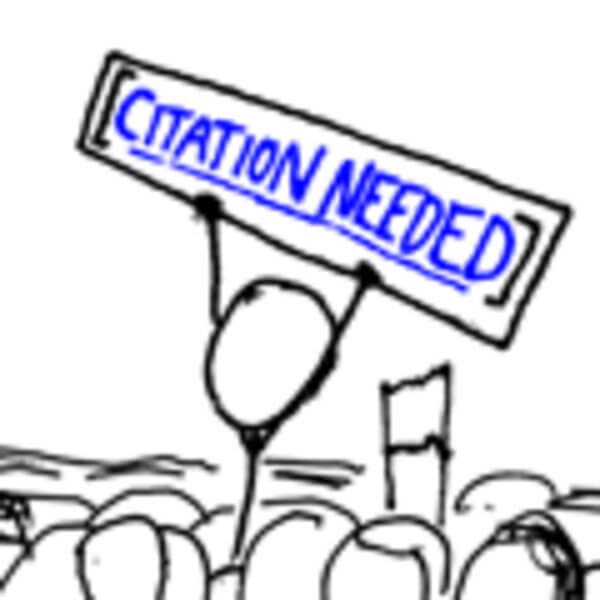
Don’t feel like you need to actually prove this extreme assumption. Jamie, can you pull up that Scientific Hypothesis chart that he himself showed us.

He has a really stupid hypothesis, which is that proportionally more people will drive on a road until the congestion is just as bad no matter how much the road is expanded. He just finished lecturing us on how more people should understand the importance of testing your hypothesis, but he will now simply assume his idiotic hypothesis to be true, because reasons.
He could go out and actually study traffic patterns like real traffic engineers do. He could even just ask them what they think. But those traffic engineers are just dumb dumbs who will tell you things like “yes, expanding roads improves congestion, and increases transportation as well, depending on the circumstances. We think that because we’ve done it many thousands of times before and we have the data showing that it works.” In other words, they just don’t understand that when you build extra road capacity, people instantly fill it because demand for road travel is infinite.
Which is the point where the hassle and delay of traffic dissuade people again from using it.
Adam Something made the same argument above, and it didn’t make any sense when he did it either. He says that the sole reason why more people use the road is the reduced congestion, and the decrease in travel time. But then he says that the congestion won’t be any better by the end. So why wouldn’t the people stop using the road again?

Let’s take a closer look at the examples that he himself gave.
A woman that used to go and see her Mom in the afternoon, because the traffic was too bad in the morning rush – thereby spreading out the congestion – will now go in the morning instead. Like, say, a guy that used to take the train will all of a sudden realize that driving is quicker and easier, and just do that.
If we magically have 100% road usage increase from people driving because it’s faster, then driving won’t be faster. Therefore, they will stop using the road, bringing us back down to 0% increased traffic, and drastically reduced congestion. But then I guess we rebound again?
The premise of infinite latent demand is dumb. Quiet rural roads will not be magically filled up by expanding the lanes. However, something similar to infinite latent demand might be functionally close true at rush hour for some ultra-busy LA highways where the latent demand is many multiples higher than the serviced demand. But what he’s claiming now is totally incoherent. It’s like, “as you expand road capacity people who previously didn’t use the road due to congestion now use the road despite the exact same level of congestion.”

Car heaven.
He imagines this hypothetical woman, call her Mary, who wants to see her mother, but won’t because the trip will take 50 minutes pre-expansion. Then she starts going to see her mother, since it now takes 25 minutes, and she needs it to be less than 42 minutes. However, other people like her start to clog up the road again, making it take 50 minutes again. Okay, so why does she continue to take trips to her mother if it takes the same amount of time as before? Does she magically have to because we expanded the road?
What about the guy, we’ll call him Dave, who realized that driving was faster than taking the train when his trip time was cut from 40 minutes to 20 minutes, and it needs to be less than 22 minutes for this to make sense. Now that his trip is back up to 40 minutes due to an (idiotically) assumed 100% increase in traffic, why would he not go back to using the train?
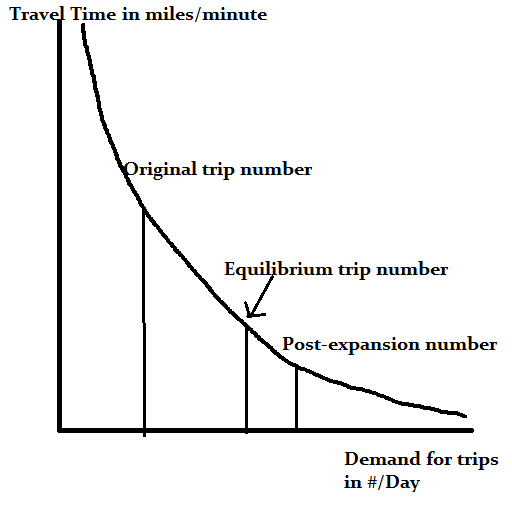
The toy model he would have used if he knew what he was doing.
Here’s a graph I made showing what would actually happen even under his dumb premises. Some of the people would stop driving as others flocked to the road, since their individual speed threshold tolerances had been exceeded. Dave is a good example of this, since he barely finds the road fast enough even with the improvements. Mary will probably continue driving, since the road is much faster than she desires. At some point we would reach a balance where the average speed driven is higher than it was pre-expansion, the congestion is lower, and the traffic is higher, but not double.
Except, this toy model isn’t even being correctly applied here, because it still assumes infinite latent demand only dependent on a certain time cost per mile driven. The model assumes that if you could teleport instantly, at least using the road, that people would make infinite trips on it, which is obviously not true. Hell, if you could teleport anywhere in just one second without using the road, would you spend all your life teleporting? Of course not, but you’d have to believe that in order to believe this simplistic model, which doesn’t even show what he says it would show. Sometimes people just have to make a number of important trips, and will sit in congestion for hours if the roads aren’t expanded.
The key realization here is the road itself has an effect on people’s behaviour. And people’s behaviour generates the traffic. The number of people that choose to drive is not fixed. Taking away space in the same way will reduce traffic, especially if you take it away to build an alternate form of transportation, like a bus or a bike lane, that can handle that traffic and give people a reason to switch. This is the concept of induced demand and it’s incredibly important.

No, it won’t. It will make life annoying and unpleasant and lead to extreme congestion, except if you had something stupid like a superhighway in a quiet rural area, in which case expanding the road wouldn’t have “satisfied” any latent demand, because there was none. He goes on to say that this holds no matter how much you expand the road. And this is the guy who lectured us all on the scientific method, which includes testing your hypotheses.
I agree with this guy on one thing, we really do need more kids to understand the scientific method. That way less people will grow up and say things like “you can infinitely expand a road and you will always have the same congestion.” Or at least they’ll go check up the data from actual traffic engineers before doing so publicly.
Solving the ongoing traffic nightmare that has frustrated Southern California’s commuters for decades is an issue that fascinates drivers across the country. But a recent New York Times investigation that examined congestion found that widening highways may not be the answer to improving traffic flow.
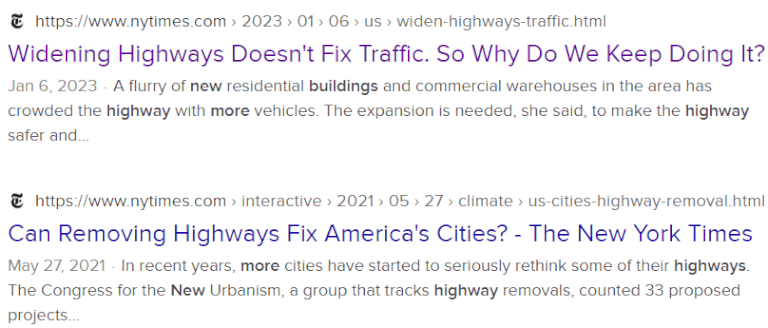
Yes, the New York Times “investigated,” this problem. By “investigated,” I mean they also rehashed tired nonsense about perfectly induced demand. If you’re wondering why I’m not quoting them they’re behind a paywall so I have to rely on this proxy.
As a quick aside, someone claiming to be a Traffic engineer slaps down the “induced demand,” fallacy. I have no way of verifying their credentials, but they are repeating what actual traffic engineers will tell you.
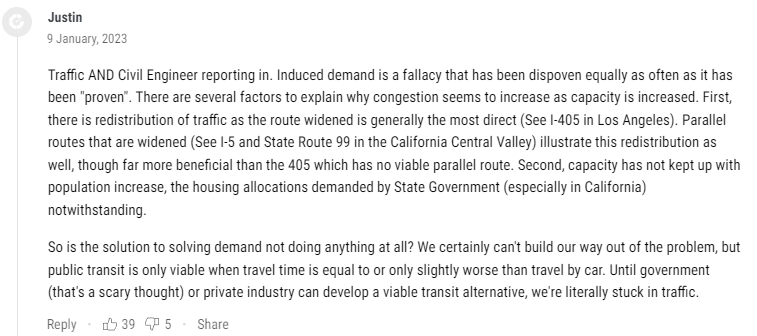
Traffic AND Civil Engineer reporting in. Induced demand is a fallacy that has been dispoven equally as often as it has been “proven”. There are several factors to explain why congestion seems to increase as capacity is increased. First, there is redistribution of traffic as the route widened is generally the most direct (See I-405 in Los Angeles). Parallel routes that are widened (See I-5 and State Route 99 in the California Central Valley) illustrate this redistribution as well, though far more beneficial than the 405 which has no viable parallel route. Second, capacity has not kept up with population increase, the housing allocations demanded by State Government (especially in California) notwithstanding.
Anyway, back to the piece.
While the story focuses on a famously clogged freeway in Los Angeles — Interstate 710 between downtown L.A. and Long Beach — it also looks at traffic problems in New Jersey and Houston.
The conclusion is that, while adding lanes can ease congestion initially, that so-called remedy “can also encourage people to drive more. A few years after a highway is widened, research shows, traffic — and the greenhouse gas emissions that come along with it — often returns.”
Houston’s Katy Freeway is a world-famous example of this –
Again with the Katy Freeway. It never ends.
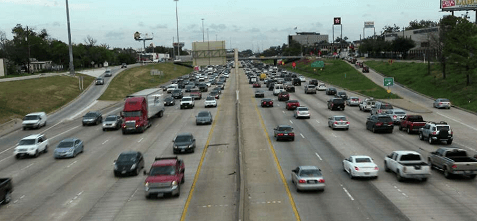
They never leave this goddamn freeway alone, and they never stop claiming that it’s 26 lanes wide. You can clearly see in the above picture that the freeway is five lanes each way. There are wider highways that they could whine about, but these people don’t know anything. Instead, they people go and find pictures, possibly photoshopped, of super wide highways and then call them the Katy Freeway.
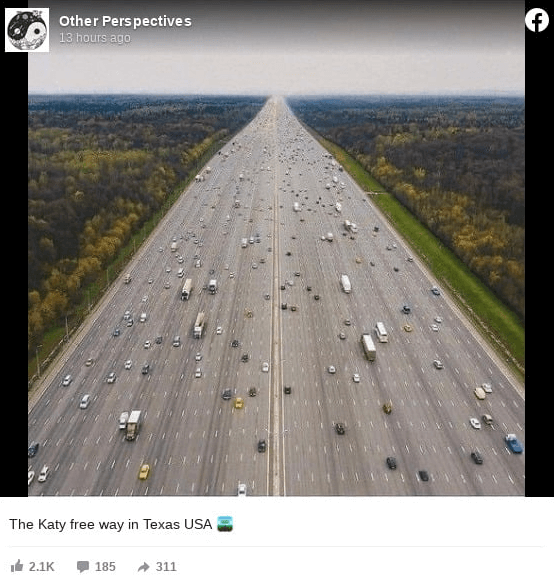
Take the above. This is not the Katy Freeway. This is not Texas. This is not America. This is not North America. This is probably not even reality.
The Katy Freeway is in Houston and is a part of Interstate 10, which runs across the Southern and Western U.S. Using Google Images, Lead Stories did not find any authentic images of the Katy Freeway that matched this image. According to a fact sheet from the FHWA, the largest section of the Houston portion of Interstate 10 only spans 12 lanes, far fewer than the highway shown in the Facebook post.
The Katy Freeway is only 12 lanes at its widest, 6 lanes each way. Why do these people continue insisting otherwise by showing misleading shots including frontage roads and off ramps?
Other social media posts that use the image have claimed that the image depicts the G4 Beijing-Hong Kong-Macau Expressway in China. Although Lead Stories could not locate the origin of the image, the color correction, season and other elements of the image are visually similar to images of Russian highways.
No one is sure where this image comes from and I strongly suspect it’s a photoshop. What we can be sure of is that it is not the Katy Freeway in Houston.

For more asininity, let’s head on over to Vox. I wonder what road they’re going to be bitching about?

Three seconds in and my jaw has hit the floor due to my shock.
At it’s widest point right here it spans 26 lanes.
Stop. Saying. That. It’s. Not. True.

The Katy Freeway didn’t start out this way, but by 2004 it was ranked the second worst bottleneck in the country.

Seems like they should expand the highway to satisfy the existing demand.
To accommodate the growing commuter class.
And growing population period.
The city began a nearly $3 billion expansion project to add the additional lanes. The solution seems natural, more lanes equals less congestion. But traffic didn’t get any better, in fact it got worse in both the morning and afternoon commutes.
What. The. Fuck. Are. You. Talking. About?
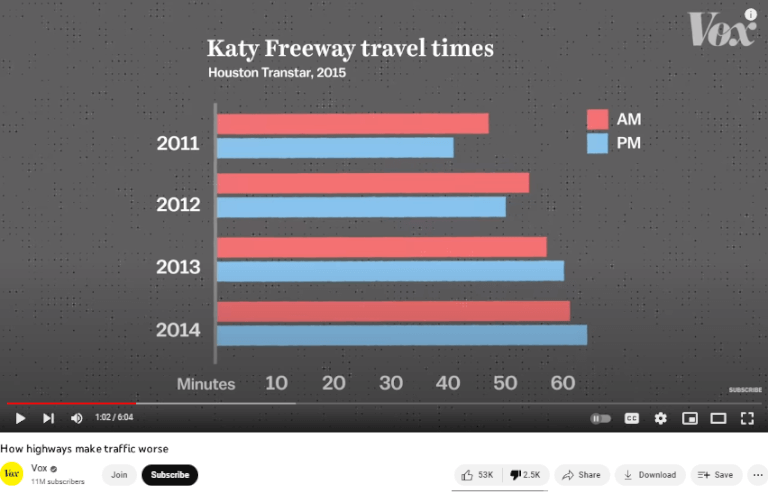
They include this graph which “proves” that congestion didn’t get any better by looking at growing commute times AFTER the project was completed. Even if I accept their numbers, and I’m not sure I do, this is such fraudulent analysis that I simply cannot believe it is due to incompetence. The highway improvements started in late 2003, really got going after 2008, and were entirely completed in 2011. Here’s what the commute times looked like before and after.

Here is a graph of what you might think the commute time increase would be like, according to Vox and all these other disingenuous midwits.

This is what it actually looks like.
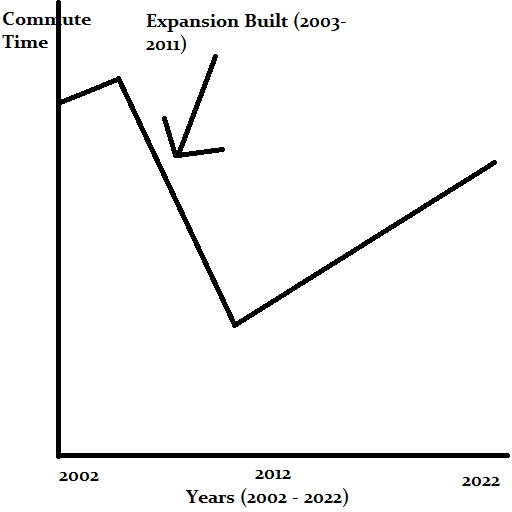
Do you see how utterly fraudulent it is to start from after the expansion was completed? Why not before? And by the way, here’s the population of Houston over this same time period.
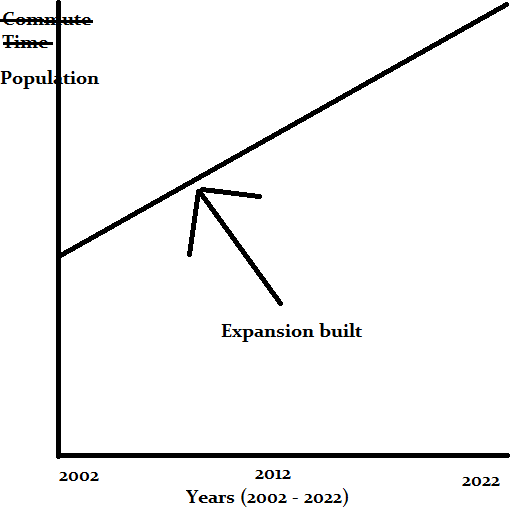
So the population does this, but the commute times do this. Sort of looks like expanding the highway worked, no?

Vox admits that the Katy Freeway was marked in 2004 as the second worst highway for congestion, at least by some groups. Do these same people mark the Katy Freeway as the second most congested highway in America today?
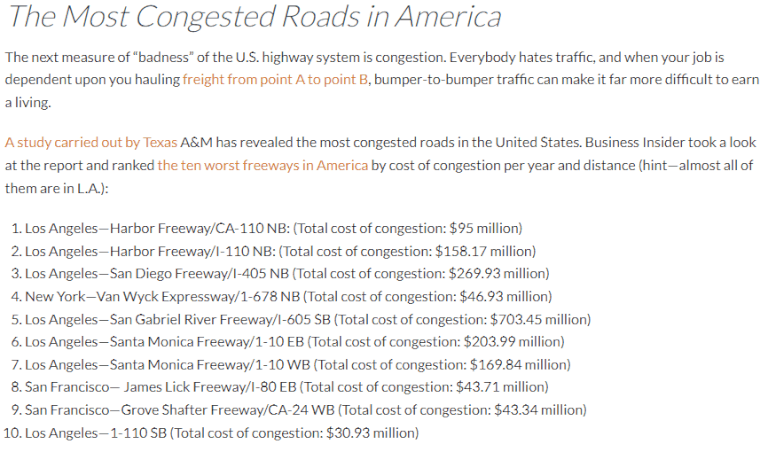
No, they do not. Searching for “most congested highways America,” or anything like it does not give us the Katy Freeway. The above screencap is from here and is from Business Insider. DailyBeast ranks the 50 worst highways by congestion/commute time here, and Katy Freeway isn’t mentioned.
Okay but let’s look at total congestion for the whole city. I have been informed by these Urbanite Bugcreatures that expanding highways makes congestion even worse even if that particular highway only has exactly proportionally increasing congestion, due to more people now taking the highway and blah blah not enough parking blah blah other roads overworked blah blah. So Houston has to be right at the top of the list of most congested cities, after all, there’s so much driving that the filthy suburbanites have to do, right?
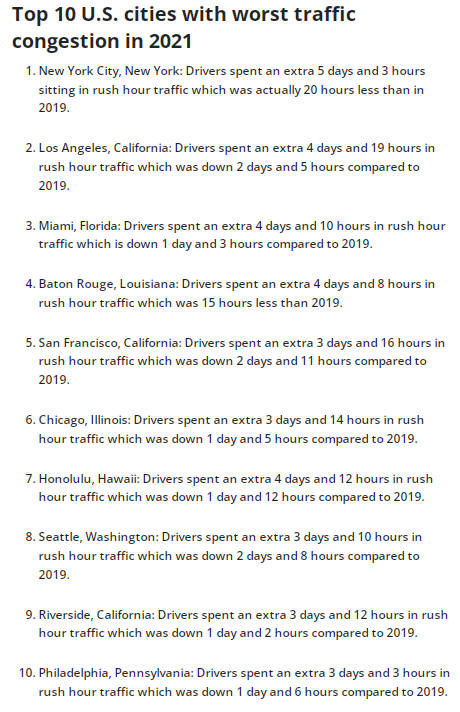
No, not right. Even when you look at total time spent stuck in traffic, Houston is way down the list with about 60% the bumper to bumper hours of New York City. For some strange reason, shoving tons of people into an area doesn’t relieve congestion, despite “muh densification.”
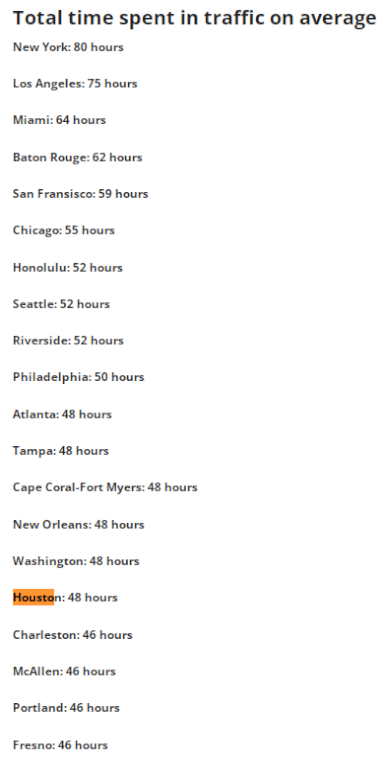
The Vox article whines about “suburbanization,” “suburban sprawl,” and Houston in particular. Then they hit on another familiar topic.
(1:30)
The instinct to widen highways to relieve traffic makes sense, but there’s a reason it doesn’t work, due to a concept called induced demand.

I’m not going to bother deboonking this, since she makes the exact same error that Miser-MicromobilityNYC made above. Like I said, these people just all regurgitate the same nonsense all the time.
(3:00)
In the end you’re left with more drivers, and congestion that’s at least as bad as it was before.

JFC. I fucking hate these snarky midwits so goddamn much. Imagine blithely saying that expanding the roads leads to at least as much congestion as before if not more.
(5:00)
And if building more highways results in more drivers and congestion, then removing them could have the opposite effect.

No. It. Fucking. Won’t.
For example, the city of Boston removed a freeway in its city center in the 1990s, and replaced it with a Boulevard with biking and bus lanes and more space to walk. It reduced congestion by 62%.
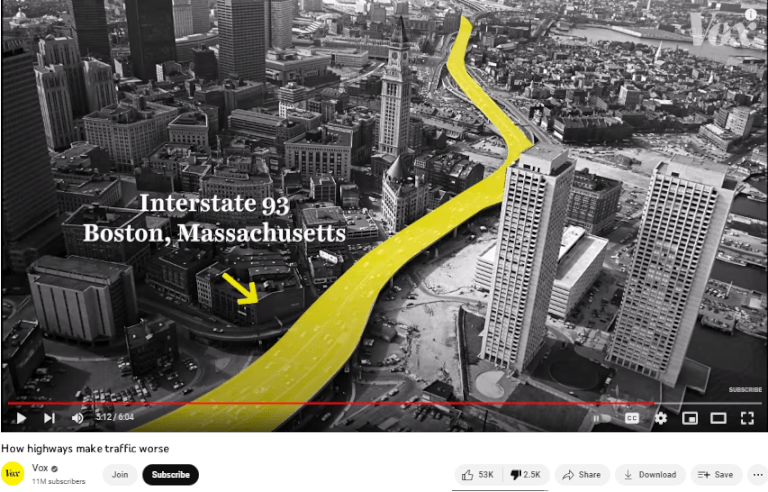
They removed a heckin highway? Wow, us CarBrAiNS would have assumed that would lead to massive increases in congestion, but AcKsHUaLLy it lead to a decrease in congestion of 62%. We just got fucking OWNED here by facts and logic.
Or maybe not. User dcseain has something to say about that:
User OpalyankaBG:
User TheKrazyKook809:
User billalumni7760 has an even better comment:
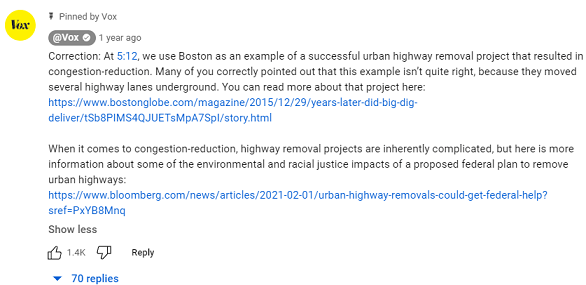
Correction: At 5:12, we use Boston as an example of a successful urban highway removal project that resulted in congestion-reduction. Many of you correctly pointed out that this example isn’t quite right, because they moved several highway lanes underground. You can read more about that project here.
You hear that? It isn’t quite right to say that they removed the highway, because they like, totally did not do that at all. Like, it’s partially right to say that they removed the highway when they literally removed 0% of the highway. Like, we weren’t totally wrong when we said that the highway was removed, even though literally zero feet of highway was removed. We here at Vox are part of a serious news organization, so we’re owning our slight inaccuracy in claiming that a highway was removed when it was completely, entirely, not removed.
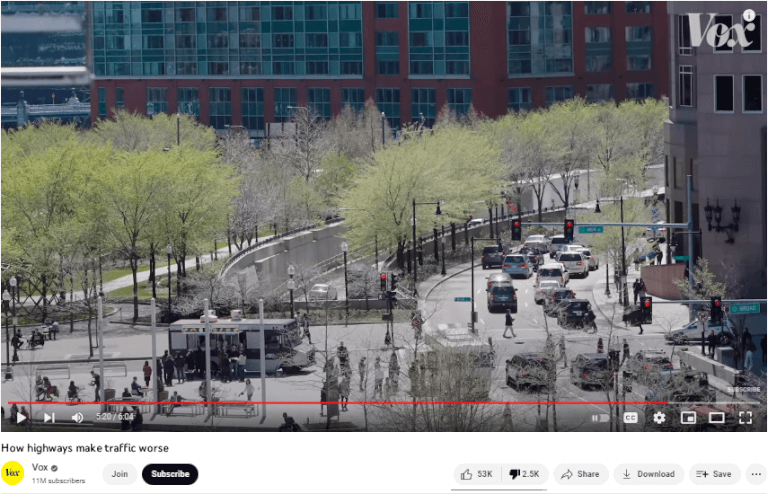
The best part is that their own video shows the underground highway coming back up, as well as the Boulevard that is above ground and which has cars on it. In other words, the highway going underground enabled Boston to have even more cars in the area. As a result of this, and removing many of the on-off ramps if the locals are to be believed, the highway congestion was drastically improved.
There does appear to be some sanity in that thread.
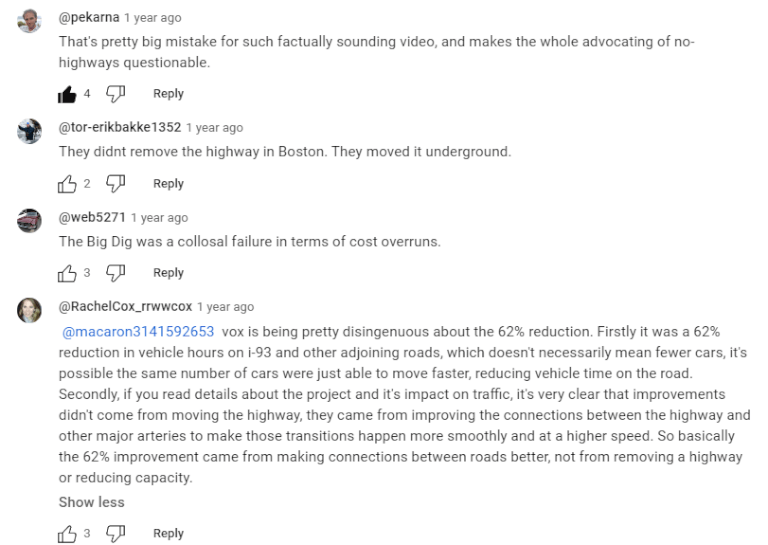
User @pekarna:

This is the best example they managed to come up with to argue for removing highways, an example where no highway was removed, and additional road capacity was built to take its place at the surface level. They could have taken data from actual lane removal projects, sometimes referred to as “road diets,” except they would probably have found enormously increased congestion and people violently angry at the urban planners.
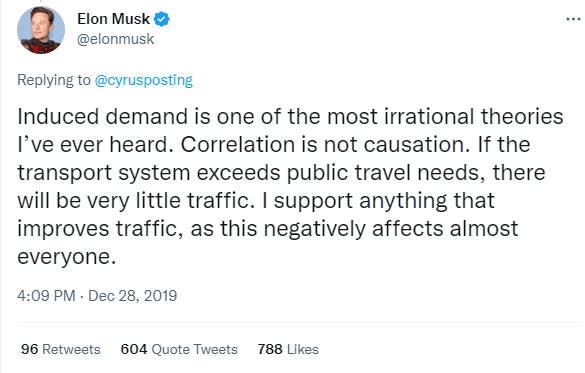
Elon Musk is a thin skinned LOLcow, but these people are so ridiculous that they manage to make him look hyper-intelligent, honest, and decent in comparison.
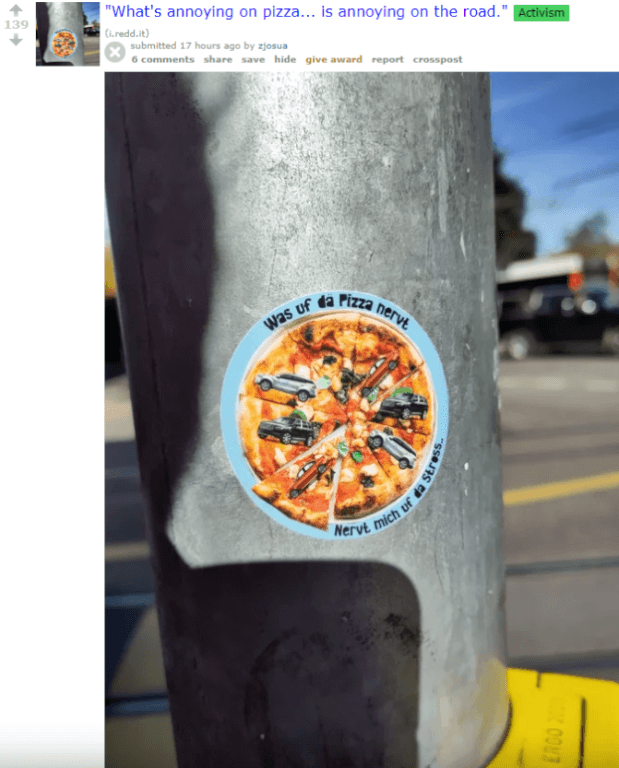
They really are “the left can’t meme: road edition.” It is aggravating watching these snarky midwits mindlessly repeat slickly edited nonsense over and over and over again while never examining their idiotic premises or bothering with something so mundane as looking at data from the real world.
Expanding the Katy Freeway reduced travel times, and this is their best “real world” example that argues against expanding highways. Getting rid of the Boston highway never actually happened in fact more surface road infrastructure was built, and this is their best “real world” example arguing for removing highways.
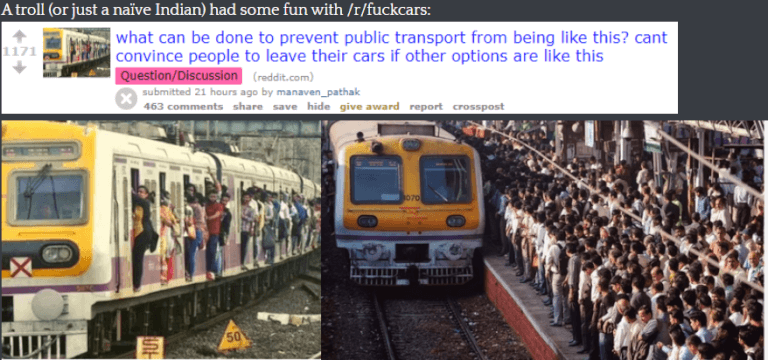
I have to end it here. This is already getting too long, but in the next piece we’ll cover this weird “deny then justify,” they do about how “induced demand,” doesn’t exist for trains, and also that it does exist and it’s a good thing.




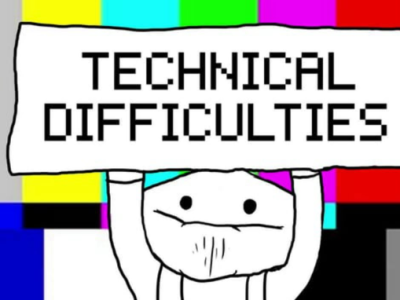

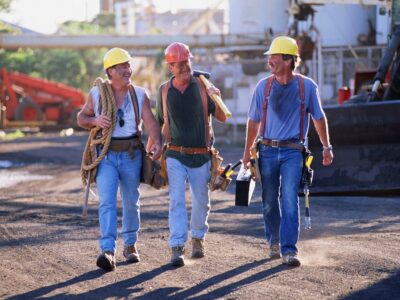






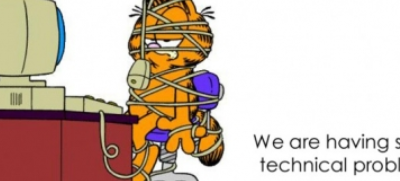
I just assume that someone called “ Miser – MicromobilityNYC” likes to have anal relations with other men
Normal people “voting with their wheels.” Antifas hate it when normals do that.